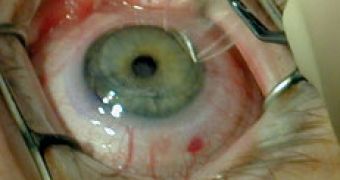90 % of the way we perceive our environment comes through our eyes. We are mainly visual creatures. But modern lifestyle with so many hours spent in front of the TV or the computer?s monitor is a strenuous task for our eyes.
At birth, the greatest danger for the baby is represented by the infections of the cornea or development of the strabismus. That's why even before bringing the child to the nursery, and even earlier if problems are noticed, the child must go through an eye check.
After 40 years, or in case of myopia with over 5 dioptres or diabetes, periodic eye checks must be done for verifying the intraocular pressure, as high values can obstruct of the draining system of the eye, producing glaucoma, affecting 2 % of the population in some western countries. If untreated, the glaucoma destroys the optic nerve.
You must not look directly into the sun without sunglasses. Such a bright light can induce permanent harm to the eyes. Those having eye problems should wear sunglasses at sunset.
Working for hours in front of a computer is very exhausting for the eyes. The frequency of the blinking decreases if the monitor is placed so high that it forces us to look up. In this case, the eyes do not get enough moisture from the tears, and can get irritated.
In case of myopia, hypermetropia or astigmatism, glasses or contact lens should be worn.
Glasses last longer and require less care. The organic crystals are more resistant to tears and weigh less than others, but are thicker. The mineral crystals have a tougher surface and do not scratch so quickly but even if they are thinner, they weigh 20 % more. For both thinness and lightness, the high refraction crystals are the best option. There are also anti-reflection crystals which can decrease the annoying brilliances.
The contact lens are almost invisible and allow a larger visual field. The rigid contact lens, more recommendable, only cover the cornea and permit a better oxygenation of the eye. The flexible contact lens are better for those who do not use them daily, as the eye does not need to adapt to them. The flexible ones must be changed each month, as they form residual deposits which resist to the most careful cleansing.
But today we are in the era of laser surgery, and "lasik" is the surgery technique through which a laser guided through the computer corrects the reflection error of the cornea.
First, with a very precise instrument, microkeratome, a layer of the cornea's surface is removed and left apart. With the laser, a cornea portion is cut off so that irregularities that determined myopia, hypermetropia or astigmatism are compensated. The initially removed cornea layer is used as a natural patch which covers the cut part and adheres to it.
This treatment is recommended for patients with a myopia of -1 to -10 dioptres and hypermetropia till + 3 dioptres, and an astigmatism up to 4 dioptres. For lasik, the cornea should accomplish some conditions. In some persons, it is too thin for this technique.
If the lasik patients suffer of over 4 dioptres, 15 % of them (all with myopia) will experience nocturnal anomalies, which can be debilitating and very annoying for those with night shifts, like truck drivers. Still, most patients reach complete visual ability for that age from the first night of surgery, rarely after several days.

 14 DAY TRIAL //
14 DAY TRIAL //